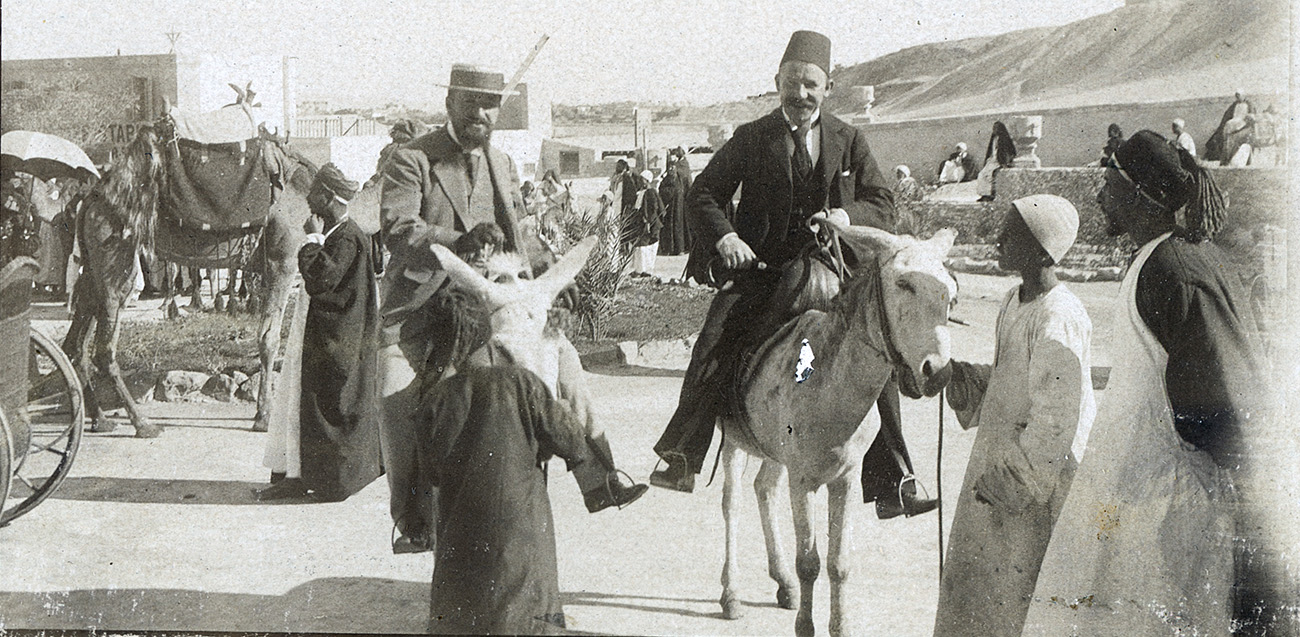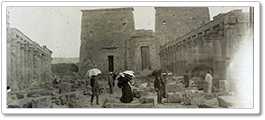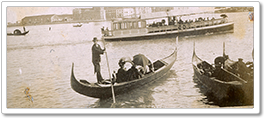Introduction:
The following exhibition features images taken in February and March of 1896 by a French tourist on a journey to Egypt and Venice. When he returned from his trip, he created a photo album titled Egypte et Venise with eighty-eight 6 X 8.5cm photographs. What makes this album so unique is that it is one of the earliest examples of amateur photography by a tourist. Prior to the 1890s, the camera was too bulky and complicated to use. Therefore, instead of packing a camera, Victorian tourists would buy large photographic albums of the places they visited from photo studios.

A Frenchman using a handheld camera on a visit to Egypt and Venice in 1986 is an early examples of amateur photography. Phot. Norbert Schiller Collection
The concept of amateur photography began in 1888 when Eastman Kodak introduced the first nonprofessional handheld camera called the box camera. The images produced were small and could not compete with the standard studio photographs, made from 20 X 25cm glass plates. However, the compact size allowed individuals the freedom to carry the camera wherever they went and for the first time take casual “snapshots” of family and friends.
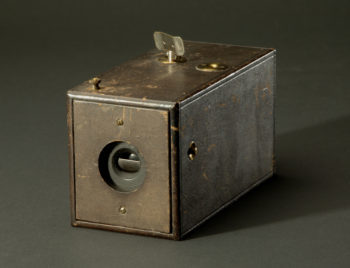
An original Box Camera made by Eastman Kodak in 1888. Phot. Mary I. Stroud, National Museum of American History
Eastman Kodak’s earliest box camera came equipped with flexible roll film that allowed the amateur to take 100 images. When done, the user took the camera with the exposed film to Kodak and they would develop the film, make prints and return the camera with a fresh roll of film. The company’s logo in 1888 was “You press the button – we do the rest.” However, as the portable hand-held camera craze took off, consumers wanted the freedom to shoot photos without having to return the camera, so Eastman Kodak created a range of box cameras that could be loaded with roll film and or small glass plates.
By the early 1890s, European camera manufacturers, most notably the French and the Germans, joined the hand-held camera trend. Like the Kodak box cameras, the European models offered the option to shoot using either flexible roll film or the more traditional method of using glass plates that varied in sizes from 4.5 X6cm to 9X 12cm.
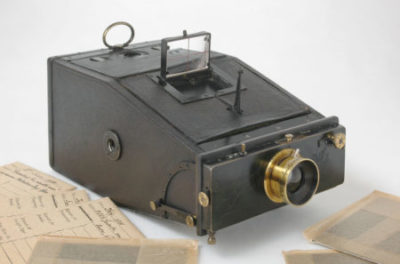
Joux Steno-Jumelle plate camera. Phot. Steve Given
The downside of the amateur photography revolution was felt mostly in popular tourist destinations such as Italy, Egypt, Palestine etc. where photographic studios depended on the sale of their expensive souvenir photo albums. With more tourists taking their own pictures, studios had to find alternative sources of revenue. For many, it meant printing affordable postcards instead of expensive large prints and selling and processing film and other camera accessories to meet the demand of the growing armateur market.
A similar revolution happened in photography just over a hundred years later with the advent of the digital camera. As before, professional photographers and photo studios had to reinvent themselves to remain relevant.
After having corresponded with a number of specialists in 19th century photography, I learned that it is nearly impossible to ascertain the exact camera used in the following exhibition without seeing the original negatives. However, by looking at the angle of some of the photographs, and assuming that the photographer was of average height and that he was holding the camera at eye level when the pictures were taken, I learned that he was most likely using a Jumelle type camera. And because each of the pictures has a slightly different color cast, I suspect he used 6 X 9cm glass plates instead of flexible roll film which would give the same cast throughout. Some of the leading French camera manufacturers in the early 1890s making Jumelle cameras were Jules Carpentier, Lucien Joux & Compagnie and Etablissements Mackenstein.
I would like to thank Jos Erdkanp and Steve Given for taking time to answer my questions and share their knowledge about handheld cameras in the late 19th century.
